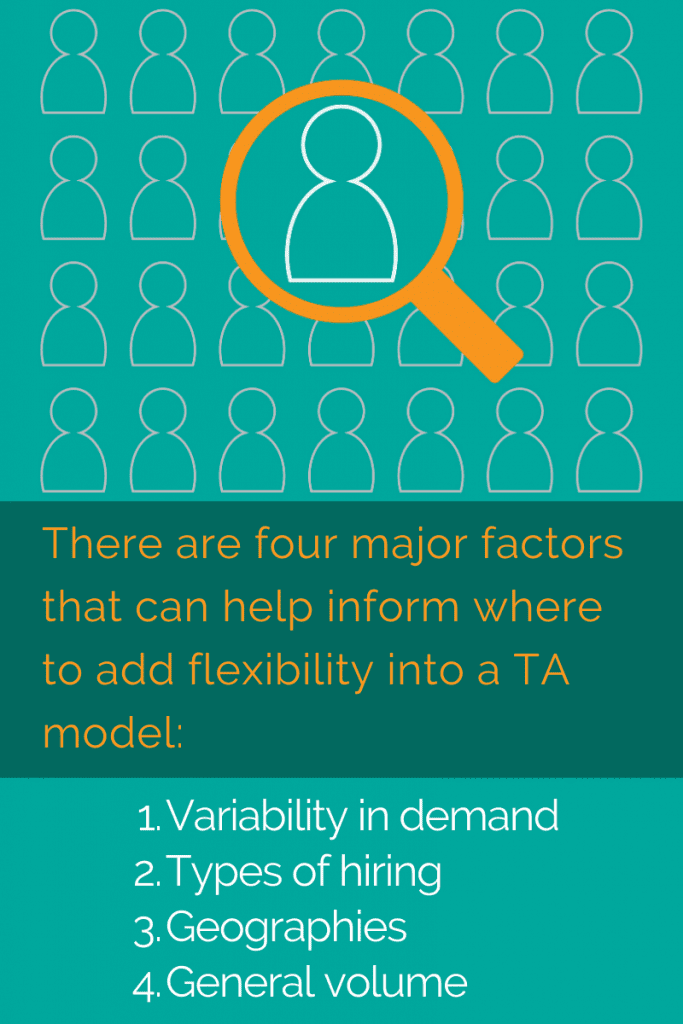Deploying an adaptable TA strategy provides a competitive advantage in an uncertain market.
By Debbie Bolla
As market conditions continue to change, organizations that approach business decisions with adaptability and agility in mind will be better positioned to achieve their goals. A focus on flexibility allows businesses to stay ahead and be proactive during sudden changes. And this is no different for talent acquisition teams.
“Flexibility means TA has the ability to shift with the potential asks of the business with relative speed,” explains Marissa Geist, chief operating officer of Cielo, the world’s leading strategic recruitment process outsourcing (RPO) partner. “Understanding what the business is focused on and working towards is the best way to ensure talent acquisition isn’t going to fall behind.”
Most businesses are certainly undergoing major strategic shifts, Geist says, whether that is restructuring their workforce, expanding into new geographies, or divesting a product or service. In all of these instances, TA teams that are flexible will have an understanding of how these changes translate to the talent strategy and have the ability to respond effectively and efficiently. Take, for example, supporting an increase demand in hiring volume. If an organization is planning on opening operations in a new geography, talent acquisition leaders need to be agile in shifting resources to conduct a competitive analysis, and proactive in building a pipeline of critical talent for roles that must be filled. The talent the organization needs today won’t be the same this time next year, so your structures and way of working have to take that into account.
Being Able to Flex and Scale
Geist says there are four major areas that can help inform where to add flexibility into an organization’s talent acquisition model:
- Variability in demand. Organizations can determine their level of variability on a monthly and yearly basis by looking at historical changes in demand during business cycles. Request forward-looking business plans as a basis for new expectations.
- Types of hiring. Organizations should make a roadmap of their hiring requirements; some will a limited number of job titles while others will need to seek many skill sets. Your business stakeholders won’t translate shifts in work to types of talent, so this is where understanding future product or strategic shifts will give you a good place to start.
- Geographies. The organizational footprint in a specific geography will often determine the amount of support required. Large or more mature geographies typically have more volume and demand for TA support while emerging markets tend to fall at the tail end of the spectrum.
- General volume. The size and scale of the operation has a big impact. A business that hires 1,000 people per month will operate differently than one with 50 hires per year. Additionally, if you have to hire all of your demand in one month per quarter, your planning should account for highs and lows in your cycles.
Once leaders assess these four areas, they will have the ability to prioritize where they can have the most impact by tailoring their TA operating model to build in scale and flex.
Specialized Roles & Expertise

One recommended area of focus is candidate attraction, including recruitment marketing. “Five years ago, talent attraction was primarily the domain of a skilled recruiter or sourcer. Now, a comprehensive program, fueled by technology, aided by recruiters is market-leading, but that can’t be designed requisition by requisition,” she explains. Having a leader oversee candidate attraction will make a huge difference in this uncertain market. This role includes many facets: advertising channel management; automated outreach; brand reputation; and the development of talent communities. Having one dedicated member leading the charge will drive a proactive talent acquisition engine.
Other areas of talent acquisition that would benefit from have a specialized leader include technology, automation and reporting and analytics. Skills and abilities in these areas are rarer in Talent Acquisition, so think about leveraging your company’s resources, or consider a partner.
Rethinking Recruitment
“It’s an interesting moment of transformation,” says Geist. “In the downturn, a lot of companies have divested corporate functions or have slowed them down. So there is an opportunity to build back from a clean slate and do it in a way that makes sense for the future.”
For a scalable approach, Geist recommends having an appropriate mix of internal leaders, partners, and automation. “You want to make sure there are build elements that give you expertise in your company to help make it stable,” she explains. “Whereas elements that could benefit from dedicated and customized support, shifting onus off the business, are better for partnerships.”
As for automation, it’s certainly not a short-term play, and technology’s impact is only going to become greater in the future. The changing market conditions have provided the opportunity to look at different point solutions and see how they add -or don’t add -up. With the slow in demand for TA leaders, now is the time to reassess technology. “Get rid of all technology that is ancillary, underutilized and created for a moment in time,” says Geist. “It will make it easier to maximize technology and automate in the future.”
Because now is the time to rethink recruitment.














